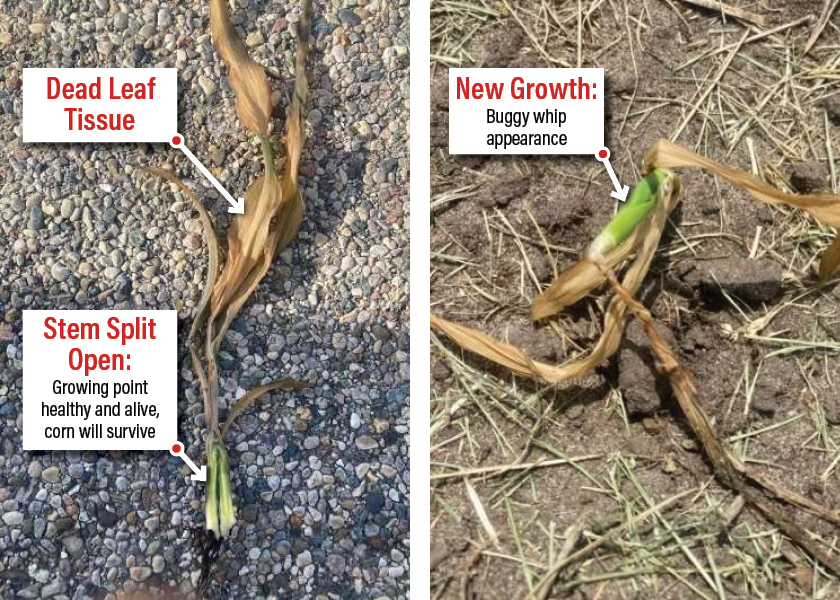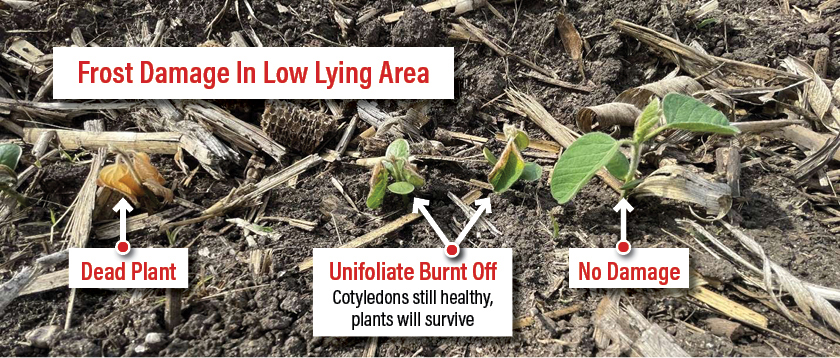The frigid air that blew through the northern Corn Belt last weekend left its mark on corn and soybean fields. From burnt leaf tissue to blotchy, curled leaves, Farm Journal Field Agronomist Missy Bauer shares these tips to evaluate frost damage.
Around B&M Crop Consulting, headquarters in Coldwater, Mich., most of the corn ranges in size from V2 to V5 with the main growing point still below the soil surface. (The growing point is not above the soil surface until V6 or 6-leaf collar corn.)
To ensure the growing point is OK, Bauer says to split open the plant from the base of the crown up.
“If the plant is a bright white to yellow color (not brown or mushy) then it should keep growing,” she explains. “Don’t be alarmed if the plant has some buggy whipping [twisted whorls] – that’s just the new tissue replacing the old tissue.”
Bauer and her team have observed numerous fields with some blotching and leaf damage. The fields have a white or greyish cast to them as you drive by, which is the damaged soybean tissue and leaves that have rolled or flipped over.

“Pay particular attention to the low-lying areas and sandier soils,” she says. “As we saw with the earlier frost issues, no-till fields, in many cases, are worse.”
When it comes to soybeans, this is the second or third major frost event (for those planted ultra-early), depending on planting day.
“Soybean fields need to be scouted yet again to evaluate stands and determine final plant population,” Bauer says. “I am most concerned about fields already marginal on stand counts due to prior frost events.”
Bauer is comfortable keeping stands of 65,000 to 70,000, if they are uniform. To determine plant populations, follow the instructions outlined in this Purdue University Extension tip sheet to use a hula hoop for 15” and narrower rows and a yardstick for 20” and 30” rows. The Extension bulletin also has information on percent of normal yield based on final populations, which is helpful in making replant decisions.

When counting plants be sure to count only ones that will survive, Bauer adds. If the unifoliate leaves are burnt off but the cotyledons are healthy, those plants will survive. If a plant is burnt below the cotyledons, it won’t survive. If the stem below the cotyledons is not firm and doesn’t have good turgor pressure, it will also likely not survive.
“The younger beans seem to be heartier than the older plants,” she says. “Many beans in the area are anywhere from unifoliate to second trifoliate.”
At this point, Bauer says, it’s important you don’t add any more stress to corn and soybeans already under stress.
“We recommend holding off on applying your post-emergent herbicides for 120 growing degree days (or heat units) from the time of the frost. With the temperatures thus far and with what’s forecasted for the week, it would likely be Sunday once we have accumulated the heat units,” she adds.
Many soybean fields in her area are just getting ready for rolling at the V1 to V2 growth stage. If your population is already thin, do not roll these fields, Bauer advises.
“Fields that have good stands and limited frost damage can be rolled. Wait until after the 120 growing degree days and the proper growth stage on fields with heavy frost damage where plants must regrow from new growing points,” she says.
Read More
Ferrie: 3 tips to address ugly corn syndrome, replant decisions and insects
Iowa Farmer Forced to Replant as Late May Freeze Wiped Out Soybeans Planted into No-Till
Ag Weather Forecast: The Heat is Coming
"use" - Google News
June 04, 2021 at 04:36AM
https://ift.tt/3pjxiv8
Hit by Frost? Use These Tips to Evaluate Damage - Agweb Powered by Farm Journal
"use" - Google News
https://ift.tt/2P05tHQ
https://ift.tt/2YCP29R
Bagikan Berita Ini















0 Response to "Hit by Frost? Use These Tips to Evaluate Damage - Agweb Powered by Farm Journal"
Post a Comment